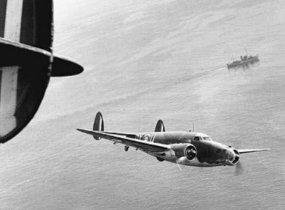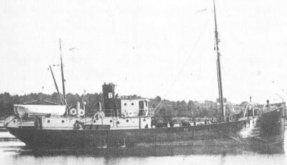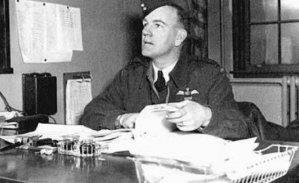Wartime Heritage
ASSOCIATION

copyright © Wartime Heritage Association
Website hosting courtesy of Register.com - a web.com company
Canadian Air Force Hero Based in Yarmouth
Norville Everitt “Molly” Small (1908-1943)
Canadian Air Force Hero Based in Yarmouth
Norville Everitt “Molly” Small (1908-1943)
by Michael Cunningham
Norville E Small was born at Allandale, Ontario 7 December 1908. In June 1931 he enlisted in the air force and was awarded his
pilots wings at Vancouver. As a sergeant pilot, he logged 3,000 hours on flying boats and twin-engine aircraft. Small’s RCAF service
ended in 1937 when he switched to flying commercial aircraft. Somewhere along the way, Small’s pilot colleagues gave him the
nickname “Molly”.
After war broke out in 1939, Molly Small re-enlisted in the RCAF and served in Newfoundland as an instructor on the Douglas
Digby aircraft. In the spring of 1941, Small’s airline experience led to an assignment with RAF Ferry Command, flying transatlantic
flights with the long-range Consolidated Catalina (called the Canso by RCAF). Senior officers described Molly Small as a “master
pilot” and “excellent tactician” who was possessed of a “burning desire to get on with the job”. In March 1942, Flight Lieutenant
Small was awarded the Air Force Cross and given command of the newly created Canso #10 Bomber Reconnaissance Squadron
(BRS) at the RCAF base in Yarmouth. Yarmouth was a very important air base in the war against German U-boats. Strategically
located, Yarmouth based patrol aircraft had the fuel range to cover much of the route cargo ships took on their way up the
coastline to Halifax to join one of the convoys.
In WWII German U-boats spent time on the surface, recharging batteries, making transmissions and attacking surface ships with
their deck guns. On 28 April 1942, Flight Lieutenant Small was on an operational patrol off Yarmouth in a Canso when he sighted a
U-boat on the surface. Diving from 500 feet, Small attempted to release his four 450-lb depth charges around the U-boat.
Fortunately for the German submarine, only two of the depth charges came away from
the aircraft, causing minimal damage to the U boat, which then escaped. On 28 June
1942 Molly Small was appointed Squadron Leader of 113 BRS at Yarmouth, flying
Lockheed Hudson’s.
Molly Small was the kind of person blessed with a great imagination and a mind that
never stopped thinking of better ways he could accomplish his mission. He had the
bottom of his squadron’s aircraft painted a dull grey which would make them more
difficult for U-boat lookouts to spot against an overcast sky. In order to get his aircraft
airborne in as short a period as possible Molly Small keep a couple crews on
emergency standby at full flight readiness 24/7. These crews slept in the hangar, they
only left to get their meals and not together. Much like flight crews during the battle
of Britain, these anti-submarine crews could be airborne within 10 minutes of getting
an alert call about a U-boat sighting. The trick was getting the U-boat sighting early enough before the U-boat left the area.
Germany required their WWII U-boats to check in with their home base by HF radio frequently. These transmissions were picked
up by RCAF Direction-Finding equipment allowing the U-boat’s location to be plotted. The existing Canadian policy had this vital
information going to Ottawa first to be reviewed before being sent to the operational units, resulting in a significant delay.
Squadron Leader Molly Small found a way to bypass the operational centers in Halifax and Ottawa get the information directly
from the Director of Maritime Patrol Operations (MPO) in Ottawa. As soon as the Centre in Ottawa got a confirmed sighting off
Yarmouth, they called the Director MPO who then called direct to Small’s Yarmouth squadron office. This system would soon prove
its worth with U-754 patrolling the waters off SW Nova Scotia.
On the morning of 28 July 1942, an unarmed American fishing trawler the Ebb was
about 45 miles SE of Cape Sable when suddenly the U-754 surfaced alongside her.
Although the Ebb’s crew signaled their surrender the U-boat began shelling the
trawler, eventually sinking her. The Ebb’s captain and 4 other men were killed, seven
others were wounded. Her work completed the U-boat submerged. The survivors of
the Ebb were picked up 14 hrs later by a British warship.
Just 3 days later 31 July, a sighting report for U-754 was sent to Small and the
emergency flight crews were launched into action. The Hudson bomber patrol led by
Squadron Leader Small himself caught U754 on the surface SE of Cape Sable. The U-
boat crew attempted to dive but it was straddled by a cluster of depth charges before they got safely away. The conning tower of
the wounded submarine briefly surfaced in the upwash caused by the depth charges, only to be strafed by another Hudson's
machine guns before submerging again. A glut of large air bubbles was followed by a massive underwater explosion. The U-754
went to the sea floor off SW Nova Scotia with 43 men onboard. It was the first submarine kill of the RCAF's Eastern Air Command.
Effective 1 January 1943 Molly Small was awarded the Distinguished Flying Cross
and the citation read as follows: This officer has displayed outstanding airmanship,
courage and devotion to duty on operational flying in the face of the enemy over
the sea off the coast of Nova Scotia. During the last few months he has carried out
five attacks on enemy submarines carrying armament considerably superior to
that of the aircraft. Three of these attacks were successful; two of the successful
attacks were made within a recent period of six days on fully surfaced submarines
with their decks manned.
Tragically Squadron Leader N. E. “Molly” Small was killed just a week later, 7
January 1943 shortly after taking off from Gander, Newfoundland. Never one to sit
still for even a moment Small was working on a project to improve the operational
range of the RCAF’s Canso’s. The RCAF wanted to close the “Air gap” in the mid-Atlantic where U-boats were out of the range of
shore-based patrol aircraft. On essentially what was an experimental flight Small and his crew had stripped the Canso of almost
1300 lbs of equipment and replaced it with fuel. It is likely, with the changes to the aircraft’s weight and balance, flight control
effectiveness was affected causing the crash.
Molly Small and his accomplishments are the subject of Chapter 4 in the Canadian Forces book Neither Art, Nor Science – Selected
Canadian Military Leadership Profiles Volume II.




Figure 1 - Lockheed Hudson's (note camouflage)
Figure 2 – Fishing vessel Ebb
Figure 3 – Squadron Leader “Molly” Small


- World War I - Menu
- WWI Stories and Articles
- Photos - Yarmouth Soldiers
- Selection of World War I Songs
- WWI Casualties of Yarmouth, NS
- Those Who Served - Yarmouth, NS
- WWI Casualties Digby Co. NS
- WWI Casualties Shelburne Co. NS
- Merchant Mariners (1915) Yarmouth, NS
- Canadian Forestry Corps - Non Yarmouth Birth/Residence Enlistments
- US Draft Registry - Yarmouth NS Born


- World War II - Menu
- WWII Stories and Articles
- Telegraphist Air Gunners
- WWII Casualties of Nova Scotia
- US Casualties with NS Connection
- Far East/Pacific Casualties with NS Connection
- Merchant Navy Casualties Nova Scotia
- Nova Scotia WWII Casualties Holten Canadian War Cemetery
- D-Day Casualties - Nova Scotia
- CANLOAN Program Casualties - Nova Scotia
- Battle of the Bulge Casualties - Nova Scotia
- WWII Casualties Yarmouth NS
- Yarmouth Casualties - RCAF RAF Canadian Army WWII
- Yarmouth Co., Marrages WWII
- Casualties Non-Born/Residents with Connection to Yarmouth Co., Nova Scotia.
- WWII Casualties Digby Co., NS
- Non-Nova Scotian WWII Casualties Buried in Nova Scotia
- WWII RCAF Casualties Aged 16-18
- Brothers/Sisters Who Served - World War II













